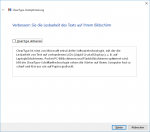Enabling ClearType in Vista is easy, you can do it in the GUI, and besides its enabled by default anyway. However, tuning ClearType in Vista is not so easy as there is nothing exposed in the GUI for tuning. ClearType is integrated into Vista. There is, however, a way to adjust ClearType in the registry.
[HKEY_CURRENT_USER\Control Panel\Desktop]
"FontSmoothing"="2"
"FontSmoothingType"=dword:00000001
"FontSmoothingGamma"=dword:000003e8
"FontSmoothingOrientation"=dword:00000001
The "FontSmoothing", "FontSmoothingType", "FontSmoothingGamma", and "FontSmoothingOrientation" items already exist in the registry. The settings for each important item for ClearType activation and tuning are:
"FontSmoothing" - a DWORD value : 1 = use font smoothing, 2 = use ClearType font smoothing. This is a REG_SZ value, not a dword. This is different from "FontSmoothingType" and is not a switch to help turn on ClearType to begin with. This tells the font smoothing to use AFTER ClearType is enabled.
"FontSmoothingType" - a DWORD value: 1 = ClearType is not used for the font smoothing, standard font smoothing is used instead - 2 = ClearType is used for font smoothing. (setting to '2' also enables ClearType)
"FontSmoothingGamma" - a DWORD value: Perhaps the most important setting for ClearType. Range is 1000 to 2200 (integer). Setting to 1000 (the default) produces the most readable text for most people (its the darkest against a white background with a black font). 2200 gives the lighest text. You may be able to go below the 1000 value, I haven't tried that yet since the official lower limit is 1000.
"FontSmoothingOrientation" : This is a hard one to figure out. It seems basically to determine if the display will use RGB, BRG, or a flat pixel structure. Most LCD screens are RGB so play with this one a little if your using a LCD display. The values for this dword are 0, 1, or 2. These values for "FontSmoothingOrientation" and what each does is represented below:
Flat = 0 - The display device has no pixel structure. This means that light sources for each color are spread equally on the pixel area—this is referred to as gray scale rendering. This is how a standard display device works. ClearType is never applied to the rendered text.
RGB = 1 - The display device has pixels that consist of three stripes in the following order: red, green, and blue. ClearType is applied to the rendered text.
BGR = 2 - The display device has pixels that consist of three stripes in the following order: blue, green, and red. ClearType is applied to the rendered text.





